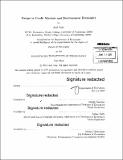| dc.contributor.advisor | Abhijit Banerjee and Esther Duflo. | en_US |
| dc.contributor.author | Jain, Anil Kumar | en_US |
| dc.contributor.other | Massachusetts Institute of Technology. Department of Economics. | en_US |
| dc.date.accessioned | 2014-09-19T21:41:10Z | |
| dc.date.available | 2014-09-19T21:41:10Z | |
| dc.date.copyright | 2014 | en_US |
| dc.date.issued | 2014 | en_US |
| dc.identifier.uri | http://hdl.handle.net/1721.1/90124 | |
| dc.description | Thesis: Ph. D., Massachusetts Institute of Technology, Department of Economics, 2014. | en_US |
| dc.description | Cataloged from PDF version of thesis. | en_US |
| dc.description | Includes bibliographical references (pages 135-140). | en_US |
| dc.description.abstract | Chapter 1 (co-authored with Ali Choudhary) exploits exogenous variation in the amount of public information available to banks about a firm to empirically evaluate the importance of adverse selection in the credit market. A 2006 reform introduced by the State Bank of Pakistan (SBP) reduced the amount of public information available to Pakistani banks about a firm's creditworthiness. Prior to 2006, the SBP published credit information not only about the firm in question but also (aggregate) credit information about the firm's group (where the group was defined as the set of all firms that shared one or more director with the firm in question). After the reform, the SBP stopped providing the aggregate group-level information. We propose a model with differentially informed banks and adverse selection, which generates predictions on how this reform is expected to affect a bank's willingness to lend. The model predicts that adverse selection leads less informed banks to reduce lending compared to more informed banks. We construct a measure for the amount of information each lender has about a firm's group using the set of firm-bank lending pairs prior to the reform. We empirically show those banks with private information about a firm lent relatively more to that firm than other, less-informed banks following the reform. Remarkably, this reduction in lending by less informed banks is true even for banks that had a pre-existing relationship with the firm, suggesting that the strength of prior relationships does not eliminate the problem of imperfect information. Chapter 2 examines the provision of public goods in developing countries is a central challenge. This paper studies a model where each agent's effort provides heterogeneous benefits to the others, inducing a network of opportunities for favor-trading. We focus on a classical efficient benchmark - the Lindahl solution - that can be derived from a bargaining game. Does the optimistic assumption that agents use an efficient mechanism (rather than succumbing to the tragedy of the commons) imply incentives for efficient investment in the technology that is used to produce the public goods? To show that the answer is no in general, we give comparative statics of the Lindahl solution which have natural network interpretations. We then suggest some welfare-improving interventions. In chapter 3 (co-authored with Robert Townsend) we present a tractable model of platform competition in a Walrasian equilibrium. Rochet and Tirole (2003) sparked a decade of extensive study on two-sided markets. However, the analysis of two-sided markets with multiple platforms has been largely ignored. We endogenize the size of each platform for different utility functions, different types of agents, and different levels of capital. Contrary to the prior literature, our economy is efficient - platforms internalize the network effects of adding more users by offering bundles which state both the number of users and the price to join the platform. Further, we show that the first and second welfare theorems are still able to be applied. Our model suggests how the equilibrium characterization of two-sided markets changes when we alter the cost structure or wealth of agents and subsequently we analyse the welfare implications of various placebo interventions. | en_US |
| dc.description.statementofresponsibility | by Anil Jain. | en_US |
| dc.format.extent | 140 pages | en_US |
| dc.language.iso | eng | en_US |
| dc.publisher | Massachusetts Institute of Technology | en_US |
| dc.rights | M.I.T. theses are protected by copyright. They may be viewed from this source for any purpose, but reproduction or distribution in any format is prohibited without written permission. See provided URL for inquiries about permission. | en_US |
| dc.rights.uri | http://dspace.mit.edu/handle/1721.1/7582 | en_US |
| dc.subject | Economics. | en_US |
| dc.title | Essays in credit markets and development economics | en_US |
| dc.type | Thesis | en_US |
| dc.description.degree | Ph. D. | en_US |
| dc.contributor.department | Massachusetts Institute of Technology. Department of Economics | |
| dc.identifier.oclc | 890148832 | en_US |
